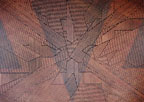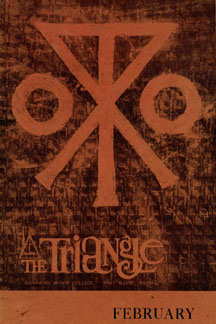| | | | | | | | |

| 
| 
| 
| 
| 
| 
| |
|
From the Concordia Triangle
Jim Nickel: Directed Motion

As an undergraduate philosophy major at Concordia Senior College in Fort Wayne, Indiana, Nickel published this essay on the depiction and perception of motion in painting. He also mounted an exhibit of eight paintings — colored shapes on a black ground, reproduced as black-and-white illustrations in The Triangle, the student literary magazine. The ideas Nickel advanced in this essay were critically important in his early work several years later in St. Louis. His Pedestal Chair, for example, has a clear relationship to Figures 1 and 2, below, as do many of his early constructions made from 4-by-4 posts. Notions of movement, perceived relationships among elements, and a fascination with surface run throughout his work — painting, photography, sculpture, works on paper. The essay itself was a minor success, winning first prize in Indiana’s statewide judging of student essays for 1965. | |||||||
|
Every day we observe various kinds and forms of motion — motion in growth, jerky motion, wavy motion, slow motion, bodily movement, acceleration, deceleration, and so on. Most of us think of motion as movement from one fixed point to another as an automobile traveling from Fort Wayne to Chicago, for motion must have direction for it to exist. However, for the artist who works on a flat plane in two dimensions or even the sculptor working in all three dimensions, the depiction of motion is a complex dilemma. | |||||||
 Figure 1 |
 Figure 2 |
 Figure 3 |
|||||
|
A painting is obviously a fixed and static thing, a mere point in the passage of time, yet the illusion of life could not be given except by the representation of movement. The only alternative is to suggest it. Thus, the French Impressionist sulptor Rodin could depict a man with both legs extended, one in front, the other in back. This never occurs in reality, but it is indicative of the sensational experience in watching a person walk. This is primarily the same approach of the Italian Futurists who represented movement in various positions by reproducing two or more phases of movement or by lengthening or widening the object in the direction of the movement. These were answers to the dilemma; however, both Rodin and the Futurists never succeeded in creating movement itself because in reality two visual images must exist as succeeding points in time. Of all the kinds of motion, both real and imagined, concrete and abstract, there are three types which seem basic in the universe. The first is motion away from me on a line; the second is motion toward me on a line; the third is cyclical motion. In figures 1, 2, and 3, which I have called open, the first type is suggested. Here the figures with their angles turned outward have a predisposition to disentangle themselves and, from some point in the center, diffuse outward into the blackness of space — a tendency to break out of their limits. Movement is from inside out, radiating in all directions in straight lines. It brings to mind what Rodin has said, “Imagine forms as directed toward you; all life surges from a center, expands from within outwards.” | |||||||
 Figure 4 |
 Figure 5 |
 Figure 6 |
|||||
|
In figures 4, 5, and 6, which I have called closed, the second type of motion is suggested because these figures have a predisposition to be compressed by exterior forces. Their angles are turned inward, and motion is directed toward the “germinal seed” or “seeds” in the center. Figure 4 has a hydraulic effect on the uppermost part pushing downward toward the center, whereas Figure 5 has the hydraulic effect on all four sides. In the closed figures, emphasis is upon these external forces impinging upon the sides of the figure and compressing the seeds inside. The direction of the motion is from the outside toward the center. Figures 7 and 8 suggest the third type, cyclical motion. I have called these figures offset because the ends of the center horzontal bars in both figures are unbalanced by the weight of the parts at either end. This unbalanced situation creates cyclical motion — like that of a perpetual motion machine spinning in a pinwheel fashion, the pivotal point being at the very center of each horizontal bar. | |||||||
 Figure 7 |
 Figure 8 |
||||||
|
Each figure is built upon a ratio of the number of vertical square units to the number of horizontal square units. On the actual paintings, each unit is a three-inch square; so, for example, in Figure 1 the ratio is 5:4 — five units of three inches vertical to four units of three inches horizontal. Thus Figure 2 has a ratio of 5:4; Figure 3, 6:4; Figure 4, 5:4; and so forth. Each unit is exactly ruled out so that spaces of one-half inch and one-fourth inch are created when the parts come together. Each fourth inch suggests a closer adherency than the half inch, yet it will be noticed that each half inch is offset and, therefore, balanced by one-fourth inch spaces. The color figures in the display are not only to be perceived as standing out from a black background, but a curious inversion of “ground upon field” heightens understanding of relationships. One must always look for alternatives whether in creating or perceiving. This is a conceptualistic approach, yet it helps us to see how the figures depend more on the power of expression than on the beauty of expression primarily because they deal with movement of and for itself not with movement as a characteristic or categorical aspect of the figures. Indeed, for many, the value inherent in the figures will be in their sensational or perceptual value as mere objects for experiencer. Yet an idea of the conceptual attitude behind the works will increase our perceptual enjoyment of them causing us to look more acutely and perceptively at the surface. Color does have an effect on us, maybe even more so than form, which was the primary concern. However, this is left to the viewer and to his responsiblility in choosing an indifferent or, on the other hand, a meaninfgful attitude toward the figures. It might surprise some to discover an artist’s “rationale” behind such simplicity or seemingly nonrational content; indeed, this applies to much of “modern” art. However, one might be assured by the fact that “mere inspiration” was not a factor; there was no sudden enlightenment or acting on impulse; problems were created and solved or solved and, therefore, created, as the sketches were made or as the actual works were done. Full conceptual understanding and interpretation has not yet been attained, for nature still stands in its utter confusion and the interpretation and understanding of it must also, to a certain extent, be confusing. | |||||||
| |||||||
Copyright ©2025 by Jim Nickel |
Contact: The Artist | The Webmaster |